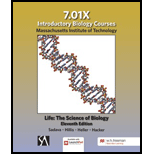
Concept explainers
To analyze:
The steps of the biosynthetic pathway that are associated with each type of mutation from the given data.
Given:
Two mutant strains of Neurospora (Leu-1 and Leu-2), the wild-type and the fused-type were supplied with different nutrient media and their growth was recorded in Table 1. The presence of growth is indicated by the positive sign (+) and the absence of growth is indicated by the negative sign (−).
Table 1: The results of the growth of different strains of Neurospora in different media.
| Types of strains used in the experiment | The growth of different strains of Neurospora in different media | ||||
| Minimal medium | Minimal medium+2-isopropylmalate | Minimal medium+leucine | Minimal medium+3-isopropylmalate | Minimal medium+α-ketoisocaproate | |
| Wild-type (haploid) | + | + | + | + | + |
| Leu-1 (haploid) | − | − | + | − | + |
| Leu-2 (haploid) | − | − | + | + | + |
| Fused cells (diploid): Leu-1, Leu-2 | − | + | + | + | + |
The following reaction shows the steps involved in the synthesis of leucine in Neurospora (Figure 1).

Figure 1:
Introduction:
The leucine is an essential amino acid that is basic in nature because of the presence of an amino group. Some organisms like Neurospora are able to catalyze the synthesis of leucine in their cells. The Neurospora is a haploid
Explanation of Solution
Neurospora is able to synthesize leucine in their cells and hence, are able to grow on a minimal medium (a medium that does not contain additional amino acids). The mutant strains of Neurospora lack the precursors that are required to perform the
From the given table and diagram, it is observed that Leu-1 strain contains a mutation in the protein that is required for the synthesis of α-ketoisocaproate. This is because this strain is unable to grow in the minimal medium supplied with 3-isopropylmalate and 2- isopropylmalate. Here the step C, i.e., the conversion of 3-isopropylmalate into α-ketoisocaproate, does not occur due to mutation, which prevents the further synthesis of leucine.
Leu-2 contains a mutant protein that is unable to synthesize the 3-isopropylmalate. This is because this strain is unable to grow on the minimal media, supplied with 2-isopropylmalate. The mutation in enzyme involved in step B that prevents the synthesis of 3-isopropylmalate from 2-isopropylmalate, thus, the final product leucine.
Thus, it can be concluded from the given data that the Leu-1 strain has a mutant protein that prevents the catalysis of step C and Leu-2 strain has a mutant protein that is unable to catalyze the step B of the given biosynthetic pathway.
Want to see more full solutions like this?
Chapter 14 Solutions
LIFE:SCIENCE OF BIOL.(LL) >CUSTOM<
- Use the sequences below to determine what type of mutation has occurred by comparing the normal sequence to the mutated sequence. Normal Gene Sequence: 3'- ATAGCTAAGCCCATGCGG-5' Mutated Gene Sequence 3'-ATAGCTAAGCCCAGGTGCGG-5'arrow_forwardName the two types of mutagens, give an example for each, and briefly describe how they cause mutations. Mutagen: Example: Description: Mutagen: Example: Description:arrow_forwardUsing the central dogma of molecular biology, explain the terms replication, transcription and translationarrow_forward
- Compare and contrast the roles of introns and exons.arrow_forwardConsider a protein that has all the 20 common amino acids in its primary sequence. Explain three ways you can mutate the protein to make it more stable. What amino acids should be mutated and why the mutations will make the protein more stable.arrow_forwardexplain the following terms: genomics, mutations(variants) & proteomicsarrow_forward
- If genes are discrete segments of DNA briefly describe how are they used as a template to synthesize a functional complementary RNA molecule.arrow_forwardAnalyze the experiments of Beadle and Tatum, and explain how their results were consistent with the idea that certain genes encode a single enzyme.arrow_forwardCompare and contrast exons and intronsarrow_forward
- Explain how a mutagen can interfere with DNA replication to cause a mutation. Give two examples.arrow_forwardIllustrate a hypothetical genetic code by spelling out the nucleotide codons of a segement of mRNA and indicating the sequence of amino acids that could be coded for in the process of protein synthesis.arrow_forwardWhat is the name of the enzyme is responsible for transcribing the DNA sequence into mRNA? In your own words, explain what this enzyme does.arrow_forward
 Human Biology (MindTap Course List)BiologyISBN:9781305112100Author:Cecie Starr, Beverly McMillanPublisher:Cengage Learning
Human Biology (MindTap Course List)BiologyISBN:9781305112100Author:Cecie Starr, Beverly McMillanPublisher:Cengage Learning
